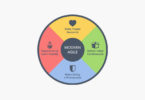What is B2G?
The acronym B2G stands for Business-to-Government, a business model that refers to businesses selling products, services or information to governments or government agencies.
The term is often used to refer to the public sector marketing and involves marketing products and services sold to different government levels through integrated marketing communications techniques such as branding, strategic public relations and other digital communications such as advertising and websites.
B2G businesses need to respect complex government procurement regulations and have often restrictions on technology usage and vendor engagements. When the government agencies announce the need to purchase specific services or products for their organisation B2G businesses can bid on government projects or products expressing their interest. Along with the fact that government agencies tend to favor businesses that have prior experience working on government projects, working in this vertical market is not easy and implies long acquisition cycles.
How to Effectively Position Your Business in the B2G Market
Having Marketing Strategies in place becomes crucial to come up in the complex market of public government contracts.
If you are working in the B2B market, in this article you can find few quick and dirty tips able to support you building a strategic plan and find out loads of related tactics able to get you great results. Even though you must be prepared: it could take years to get there, which is another good reason to start off with the right foot.
1. Understand Your Customer and Offer Constantly Updated Products
The first step here is to define your mission and identify your government audience. Identify what this audience is searching for online, what they are watching, consuming, liking, and sharing, then create buyer personas and understand the journey they could take to get to know your company and products.
Once you start to identify the right business opportunities for your company, you could easily move to the key element: win the competition building breakthrough IT and marketing projects, which means tying your services and products to government priorities. These priorities could be: providing new services to citizens, updating legacy systems and general IT modernisation, better securing its IT systems, data accountability, and transparency.
While sweeping through small digital agencies or bigger companies, even governments, not just private businesses, want to hear about trends and listen more to someone getting their challenges. Government agencies especially want to know what solutions these companies are developing to solve those challenges, and how these solutions offer better experiences to everyone, citizens as well as the government agency itself.
2. Build a Compelling Website Supporting Your Strategy and Brand Positioning
Having a useful product is not enough if you are not able to communicate it through every breath your company takes. You can start defining your identity and branding focusing on the optimisation of your website around the needs of your potential government customer especially in terms of SEO and User Experience. Your website is your main marketing tool and it might seem something trivial to state but too often companies still rely on poor website designs, vague product or service offerings, and inaccurate capabilities statements.
B2G companies cannot rely on website brochures, they should rather build engaging and responsive landing pages, able to tell a story, a problem, or an opportunity using compelling call-to-action and interactive content. Videos and infographics are great forms of visual storytelling and are also great ways to provide useful content (see point 4 below).
3. Build Trust and Credibility
The first way a company can establish credibility outside is offering customer testimonials and building case studies, which could be related to generic clients or even better to government vendors (being aware specific rules apply to them both for testimonials and case studies).
But you don’t necessarily need to have a previous experience working with government agencies to prove your credibility and authority: depending on your industry, there are other ways to establish credibility and trust. One is to work on projects of public interest related to culture, disabilities or sustainability, for example. Similarly, if your goal is to work on public school projects you might pursue similar projects for private schools. This gives your company experience and credibility to bid on analogous projects.

4. Develop Content Marketing Programs
Another great way to build credibility and differentiation is offering valuable contents able to demonstrate your company’s expertise and knowledge in an area that is important to the customer. Great content able to educate and help them to resolve their key challenges also helps you provide something of value in exchange for their attention, contact information, and continued engagement. Moreover, well-placed content can shape a prospect’s thinking about a problem (often before they even know they have one) and show them what is possible, and how you can solve their problem.
Content such as news, blogs, videos, e-books, infographics, email newsletters, and podcasts can be distributed through a diverse mix of marketing channels hitting prospects at different points in the buying cycle giving them a reason to pay attention, engage, share and even provide you with useful information about themselves.
As well as any other audience, government decision-maker need creativity, personalised and compelling stories able to blend facts with emotions and tell the challenges they are experiencing and the opportunities they want to capture.
Offer great content is also a great way to qualify your prospects before your sales pitch starts. Similarly, do not forget to support the sales team with a toolkit offering valuable content to be shared before, during and after sales pitches.
5. Meet the Educational Need
Public sector contractors are able to stand out in a crowded marketplace offering content able to inform and keep the government audiences updated about the digital challenges they are facing. This content can be properly educational when offered by experts (internal or external to the business) through online courses and training sessions, webinars, conference sessions, white papers, etc. And this is another great way to meet your audience in different stages of the customer lifecycle.
6. Attend Events and Foster Public Relations
Alongside the educational need there is the opportunity to meet your prospect during fairs and events: during these events, both you and your prospect have the opportunity to meet and learn about each other. Moreover, government contracting is mainly about relationships with all the stakeholders involved such as key industry players, media members, etc.
7. Use CRM tools and Marketing Automation
Email marketing is crucial for content distribution to B2G businesses then CRM and Marketing Automation tools are great to reach your audience and also collect feedback and information about them, a proper self-service research that helps you qualify potential buyers.
8. Use Targeted Campaign and Ads: from Account-Based Marketing to Geo-Fencing
A great way to win the competition in the B2G market is to create compelling digital experiences to reach specific government decision-makers. To do this you can build targeted campaigns direct to a shortlist of them or even hitting one government agency at the time. Applying this Account-Based Marketing you concentrate your efforts on a very defined set of target accounts which could be a single agency or even units within a larger agency.
You could also want to test more advanced technologies such as Geo-Fencing Advertising, a location-based digital technology that allows you to select a geographic point using latitude and longitude creating a virtual “fence” around that point of a given radius in which your ads can be performed. Ads delivered through geo-fencing can help you reach a specific account or people attending an event, and, since they are highly contextual, they are also typically more effective than other ads.
9. Offer 3-D or Virtual Reality Experiences
If you are willing to surprise your government prospects, another more advanced technology you could use is Virtual Reality literarily walking government decision-makers through scenarios like in-depth explorations of products and highly interactive customer experiences.
The video below has been created by BlueText, a digital agency setting an example of a business working also for the public sector. The video summarises the case study of Xo – Etherverse which offers a good example of 3-D virtual experience applied to digital communication (despite being a case study not directly related to the government topic).
10. Use Social Media to Build Relationship
Social Media are excellent channels to distribute your great content and target your audience through Social Advertising. You don’t need to be present across all platforms but you need to find those where your audiences of prime contractors and government decision-makers are active.
Channels highly recommended nowadays are YouTube or Vimeo, LinkedIn, and Instagram. With video consumption on the rise, a dedicated platform is a must have and it will be helpful also in terms of online search (if you optimise the video properly). LinkedIn offers loads of professional data about your audiences and it is a great way to reach them through connections, advertising, and posting specific contents that use hashtags that appeal to people in the public sector.
Having a strategic plan here is crucial to reach a specific group and build a trustworthy relationship with them. Also measuring your activity and evaluating performances it’s crucial when you are focused on creating leads and get new opportunities.
What do you think about this list of top strategies? If you have any comment or you think I should add any new one, please let me know in the comments below.
Learn more:
- SocialWebTactics, B2G Marketing Guide for Government Contractors [publication date n/a]
- Allan Rubin, LinkedIn Article Marketing to Government: 7 Reasons to Invest in B2G Content – June 26, 2018
- SpeakerBoxPR, Seven government marketing tips from the Gain Conference – Nov 06 2018
- TargetGov, 5 Effective Marketing Strategies For Government Contractors – May 18, 2018
- Bluetext, 6 Innovative B2G Digital Marketing and PR Strategies – September 29, 2017
- Bluetext, 5 Innovative B2G Marketing Strategies For 2018 – October 30, 2017
- Entrepreneur, How to Succeed as a Business-to-Government (B2G) Startup – April 25, 2018








Leave a Comment